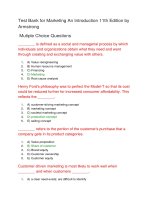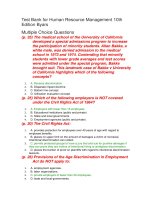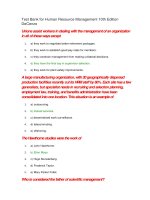Test bank for building your dream 10th edition by good
Bạn đang xem bản rút gọn của tài liệu. Xem và tải ngay bản đầy đủ của tài liệu tại đây (146.97 KB, 7 trang )
Test Bank for Building Your Dream 10th Edition by Goo
Full
file at />Exam
Name___________________________________
MULTIPLE CHOICE. Choose the one alternative that best completes the statement or answers the question.
1) The higher your number of most desirable responses on the Entrepreneurial Quiz is, then:
A) The more your responses agree with those of successful entrepreneurs.
B) The less your responses agree with those of successful entrepreneurs.
C) The more likely you are to abort your attempts at an entrepreneurial venture because of
anxiety.
D) The less likely you are to become a successful entrepreneur.
1)
2) Despite scoring high on the Entrepreneurial Quiz, your venture is unlikely to succeed if you fail to
demonstrate:
A) Commitment, determination, and perseverance
B) People prowess
C) Technical savvy
D) Financial independence
2)
3) In a study of inductees into the Babson University Academy of Distinguished Entrepreneurs, the three
attributes and behaviours cited as the principal reasons for entrepreneurial success are:
A) Openness to change, personal initiative, and perseverance.
B) Commitment, dedication, and perseverance.
C) Emotional intelligence, social intelligence, mathematical intelligence.
D) Positive attitude, social savvy, and intellectual intelligence.
3)
4) One of the common themes resulting from research into the common attributes shared by
successful entrepreneurs is that:
A) Those attributes cannot be learned, an individual is either born with them or they are not.
B) Those attributes can be learned.
C) There are no "common" set of attributes - each entrepreneurial success story is unique.
D) Those attributes are always the same - confidence, determination, and perseverance are
always at the top of the list.
4)
5) Entrepreneurs are driven by an immense desire to achieve the goals they initially set for
themselves and then to aim for even more challenging standards. This makes them:
A) Challenge-oriented
B) Success-oriented
C) Goal-oriented
D) Profit-oriented
5)
6) Successful entrepreneurs are ________ people; they want to start producing results immediately.
A) Challenge-oriented
B) Success-oriented
C) Goal-oriented
D) Action-oriented
6)
7) The best entrepreneurs have a keen sense of their own strengths and weaknesses and of the
competitive environment in which they operate. This makes them ________ -oriented.
A) Reality
B) Success
C) Action
D) Goal
7)
8) Most entrepreneurs are found to be ________ listeners and ________ learners.
A) Good; quick
B) Good; slow
C) Poor; slow
8)
D) Poor; quick
1
Full file at />
Test Bank for Building Your Dream 10th Edition by Goo
Full file at />9) The three types of reaction identified by Robinson et al. are:
A) Passion, Avoidance, and Ignorance
B) Cognition, Intelligence, and Emotion
C) Empathy, Confusion, and Clarity
D) Cognition, Affect, and Behaviour
9)
10) Which of the following did Robinson et al. define as the predisposition of the individual to
respond in a generally favourable or unfavourable manner with respect to innovation?
A) Attitude
B) Character
C) Empathy
D) Personality
10)
11) All of the following are subscales in Robinson's EAO Model, except:
A) Innovation in business
B) Desire for retribution
11)
C) Desire for personal control
D) Achievement in business
12) Which of the following entrepreneurial types prefer to identify themselves by their craft first, and
as business owners only as an afterthought?
A) Craftspeople
B) Lifestyle Business
C) Freedom Fighters
D) Empire Building
12)
13) You can usually identify ________ by the fact that their companies grow by more than 30 percent
annually.
A) Empire Builders
B) Freedom Fighters
C) Institutional Developers
D) Venture Capitalists
13)
14) These entrepreneurs go on to build larger companies through hiring and delegation of authority.
A) Team builders
B) Independent innovators
C) Deal-to-dealers
D) Pattern multipliers
14)
15) Which type of entrepreneur takes advantage of the fact that unit costs tend to shrink as volume
expands?
A) Deal-to-dealers
B) Capital aggregators
C) Pattern multipliers
D) Economy-of-scale exploiters
15)
16) Arranging financing, handling credit, and budgeting are all considered skills under which broad
entrepreneurial skill set?
A) Managing people
B) Managing money
C) Managing inventory
D) Managing capital
16)
17) Purchasing supplies and raw materials, controlling inventory, and managing the physical facilities
are skills which fall under which of the following broad entrepreneurial skill sets?
A) Managing people
B) Directing business operations
C) Setting up a business
D) Directing sales and marketing operations
17)
18) You are able to acquire many of the skills needed prior to considering an entrepreneurial career
through all of the following means, except:
A) Organizational (or club) activities
B) Vacationing
C) Job experience
D) Managing a home
18)
2
Full file at />
Test Bank for Building Your Dream 10th Edition by Goo
Full file at />19) The personal net worth required to start a business is generally thought to be in the range of:
A) $20,000-$50,000
B) $5,000-$10,000
C) $100,000-$500,000
D) Every business opportunity has its own unique capital requirements.
19)
20) Your credit rating is based on:
A) Your prior history in borrowing and repaying money.
B) The value of your home equity.
C) Your overall debt load, compared to your ability to generate income.
D) Your employment income only.
20)
21) Agencies such as Equifax Canada Inc. assemble information about how you pay your bills and
then enter this information into your credit file. An individual who is always late in paying their
bills is given a rating of:
A) R2
B) R3
C) R4
D) R1
21)
22) Social entrepreneurship seeks:
A) Social change
C) Social media business opportunities
22)
B) Welfare management
D) Financial profit
23) Well-known social entrepreneurs include all of the following, except:
B) Kenneth Lay
A) Jeff Skoll
C) Craig and Mark Kielburger
D) Shannon Tessier and Zack Patterson
23)
24) Which of the following is not among the three questions to address when confronted with an
ethical problem?
A) How will it make you feel about yourself?
B) Is it balanced?
C) Is it legal?
D) What will others think?
24)
25) A ________ should be a formal statement of a business's values concerning ethics and social issues.
A) Mission statement
B) Vision statement
C) Code of behaviour
D) Code of ethics
25)
26) A code of ethics should be guided by all of the following areas of concern, except:
A) Competition
B) Responsibility
C) Integrity
D) Citizenship
26)
27) All of the following are included in the triple bottom line assessment, except:
A) Environmental impact
B) Global equality
D) Financial performance
C) Social well-being
27)
TRUE/FALSE. Write 'T' if the statement is true and 'F' if the statement is false.
28) Researchers are unable to identify a set of common attributes, attitudes, and experiences among
entrepreneurs that appear to lead to success.
28)
29) There is considerable evidence which suggests that the "right stuff" needed to become a successful
entrepreneur can be learned.
29)
3
Full file at />
Test Bank for Building Your Dream 10th Edition by Goo
Full file at />30) Most entrepreneurs are self-confident, and with this confidence comes a strong ego.
30)
31) High energy, good health, and emotional stability are thought to be some of the "not so learnable"
qualities of successful entrepreneurs.
31)
32) High intelligence and conceptual ability are two of the most "learnable" attributes of successful
entrepreneurs.
32)
33) The Managerial Sills Inventory questionnaire can be used to develop an inventory of your skills
and capabilities in the areas of financial accounting, human resources, and ethics.
33)
34) The "typical entrepreneur" is most closely associated with the Empire Builder type of entrepreneur.
34)
35) Craftspeople are a type of entrepreneur that seek financial independence above anything else and
the freedom to spend their time as they wish.
35)
36) Deal-to-dealers are small business owners which have had more than one venture, often in quite
different lines of business.
36)
37) According to Vesper’s typology, "Acquirers" are entrepreneurs that will often take over businesses
that are in trouble and try to straighten them out or buy businesses that they can add value to in
some way, perhaps before selling them off again.
37)
38) Many small business owners experience an immediate increase in the level of personal income
they can earn.
38)
39) It is estimated that the principal reason for the failure of small firms is poor cash flow.
39)
40) Training employees, motivating people, and evaluating workers fall under the "directing business
operations" skill set.
40)
41) Your personal balance sheet includes a summary of all your assets–what you own that has some
cash value–and your liabilities or debts.
41)
42) Your credit rating is based on your income earning potential in a five year period.
42)
43) Equifax Canada Inc. is a venture capital firm headquartered in western Canada.
43)
44) Craig and Mark Kielburger are well known for the role they played in the Ponzi scheme and
eventual collapse of Enron.
44)
45) A socially responsible organization behaves in such a way as to achieve a high level of financial
performance, coupled with obvious efforts to act as good citizens and give something back to the
societies in which they exist.
45)
46) Social entrepreneurship refers to the discovery, evaluation, and exploitation of opportunities for
financial profit.
46)
4
Full file at />
Test Bank for Building Your Dream 10th Edition by Goo
Full file at />ESSAY. Write your answer in the space provided or on a separate sheet of paper.
47) Of the many attributes shared by successful entrepreneurs, which of those is believed to be the most critical to
their success? Explain.
48) List and describe the "not-so-learnable" traits of an entrepreneur.
49) Most entrepreneurs are described as having a high risk tolerance. Do you agree or disagree? Why?
50) List and briefly describe the three entrepreneurial archetypes developed by John Warrillow.
51) In addition to the proper background, attitude, and lifestyle, what else should be considered in assessing your
potential for becoming a successful entrepreneur?
52) Outline the five steps in preparing a personal balance sheet.
53) Summarize the basis for the argument that companies should give back to the communities in which they live.
54) List the reasons why businesses should be concerned with being more socially responsible.
55) Outline the three key questions in Blanchard and Peale’s Ethics Check to help you sort out dilemmas by
examining the situation at several different levels.
5
Full file at />
Test Bank for Building Your Dream 10th Edition by Goo
Full
file atKey
/>Answer
Testname: UNTITLED1
1) A
2) A
3) A
4) B
5) B
6) D
7) A
8) A
9) D
10) A
11) B
12) A
13) A
14) A
15) D
16) B
17) B
18) B
19) D
20) A
21) C
22) A
23) B
24) D
25) D
26) A
27) B
28) FALSE
29) TRUE
30) TRUE
31) TRUE
32) FALSE
33) FALSE
34) TRUE
35) FALSE
36) TRUE
37) TRUE
38) FALSE
39) FALSE
40) FALSE
41) TRUE
42) FALSE
43) FALSE
44) FALSE
45) TRUE
46) FALSE
47) More than any other single factor, a combination of perseverance and total dedication is critical. In many cases, these
qualities have won out against odds considered impossible to overcome. Determination and commitment can
compensate for other weaknesses you may have.
6
Full file at />
Test Bank for Building Your Dream 10th Edition by Goo
Full
file atKey
/>Answer
Testname: UNTITLED1
48) The not-so-learnable traits are those which experts consider to be innate. 1. High energy, good health, and emotional
stability; 2. Creativity and an innovative nature; 3. High intelligence and conceptual ability; 4. The ability to see a
better future and a capacity to inspire others to see it.
49) Despite the myth that suggests entrepreneurs are gamblers, quite the opposite is true. Effective entrepreneurs have
been found, in general, to prefer taking moderate, calculated risks, where the chances of losing are neither so small as
to be a sure thing nor so large as to be a considerable gamble.
50) Craftspeople don't think of themselves as entrepreneurs, they still have the resources and confidence to operate
independently. They are more interested in developing their skills than growing their revenue and generally work
alone or employ one other person, often a spouse. Freedom Fighters/Lifestyle Business seek financial independence
above anything else and the freedom to spend their time as they wish. Their prime motivator isn't growth, but simply
being in business for themselves. Empire Building refers to entrepreneurs who represent the 10 percent of
growth-oriented business owners who are motivated almost solely by achievement, usually measured in terms of
company growth. The empire building is the one most generally associated in popular imagination as the "typical
entrepreneur"–always busy with the next project, an insatiable thirst for growth and wealth, aiming to take over or
revolutionize markets and industries.
51) Possessing the necessary managerial skills is an essential ingredient to succeeding in any small venture. It is estimated
that the principal reason for the failure of small firms is poor management. Businesses, whether large or small, have to
perform in a number of diverse functions to operate successfully. An entrepreneur, because of the limited amount of
resources (human and financial) at his or her disposal, faces a particularly difficult time.
The business skills required by an entrepreneur (or some other member of the organization) can be broken down by
function, as shown in Table 1.1.
52) Step 1: Estimate the current market value of all your "assets" the items you own that have cash valueand list them.
Step 2: Add up the value of these assets.
Step 3: List all your debts, also known as "liabilities."
Step 4: Add up your liabilities.
Step 5: Deduct your total liabilities from your total assets to find your "net worth."
53) First, all firms make use of society’s basic infrastructureland, plants, animals, and so on–to earn a profit. Second,
companies should reimburse society for the negative consequences their activities might create noise, smell, traffic
congestion, and toxic emissions
54) Cost savings due to more efficient operations
Development of a more positive organizational image and reputation
Creation of a clearly identifiable market niche with consumers who are interested in health and the environment,
social justice, and sustainable living
Being forced to become more innovative to accommodate these values within the company’s organizational strategy.
55) 1. Is it legal?
Will you be violating either civil law or your organization’s code of ethics?
2. Is it balanced?
Is it fair to all concerned in the short term as well as the long term? Does it promote win—win relationships?
3. How will it make you feel about yourself?
Will it make you proud?
Would you feel good if your decision was published in the newspaper?
Would you feel good if your family knew about it?
7
Full file at />









